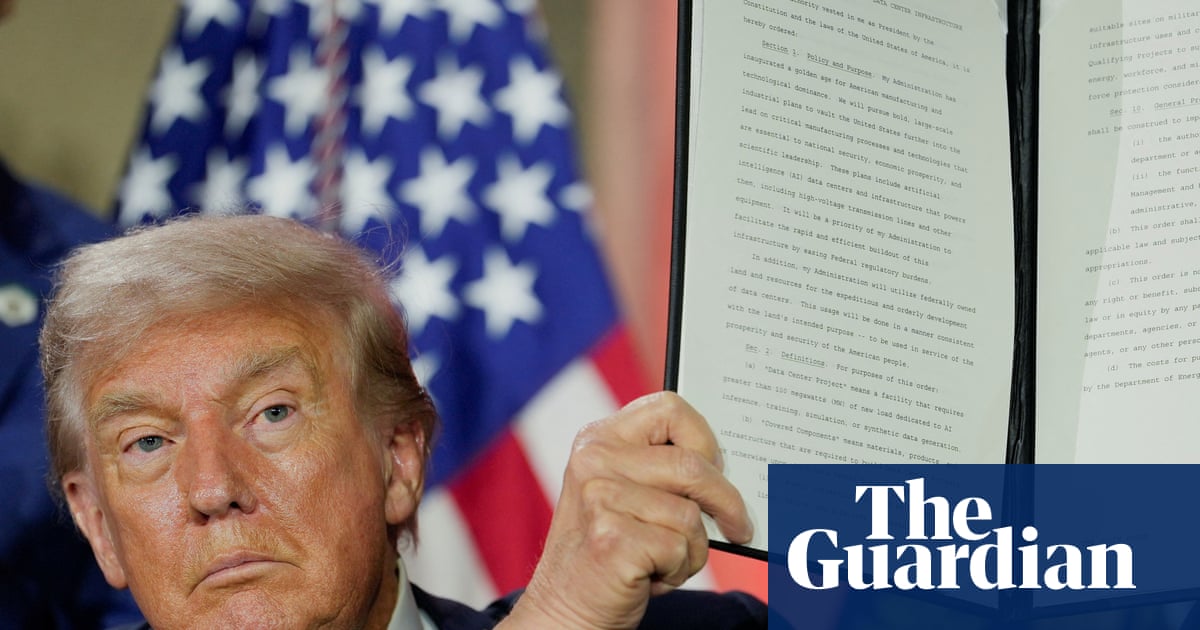Trump’s AI Summit: Power Moves in the Tech World
Donald Trump’s recent AI summit in Washington, a grand affair designed for the leaders of the tech elite, marked a pivotal moment in the ongoing discussion about artificial intelligence (AI) regulation in the United States. Hosted in collaboration with the Hill and Valley Forum and the Silicon Valley All-in Podcast, the event brought together a powerful crowd, including prominent figures like Nvidia’s CEO Jensen Huang and Palantir’s chief technology officer Shyam Sankar.
Upon taking the stage, Trump was greeted with the iconic strains of “God Bless the USA.” He dove straight into a passionate declaration: “America must once again be a country where innovators are rewarded with a green light, not strangled with red tape.” This rallying cry highlighted a clear shift in focus away from the stringent regulatory frameworks that have characterized federal oversight in recent years, particularly under the Biden administration.
A Call for Innovation
The president emphasized that his administration aimed to foster an environment of innovation rather than obstruction. “I’ve been watching for many years,” Trump shared, reflecting on his experiences with regulatory hurdles. He addressed the crowd as “the group of smart ones … the brain power,” acknowledging the critical role that these tech leaders play in shaping America’s AI landscape.
The summit, aptly titled “Winning the AI Race,” provided Trump with a platform to unveil what he referred to as the “AI action plan.” This plan is focused on dismantling existing regulations and promoting the rapid development and deployment of artificial intelligence technologies. The core of this initiative involves three executive orders that are intended to transform the U.S. into a dominant player in the global AI market.
Executive Orders and Shifting Regulations
One of the most controversial elements of Trump’s plan includes an executive order targeting what the administration labels as “woke” AI. This measure requires companies receiving federal funding to ensure their AI models remain free from “ideological dogmas such as [Diversity, Equity, and Inclusion] (DEI).” In a climate where social responsibility in technology is under scrutiny, this directive certainly raised eyebrows.
Additionally, two executive orders focus on deregulation—an increasingly vocal demand from the tech sector. One encourages the international export of “American AI,” while the other aims to relax environmental regulations, particularly regarding the infrastructure necessary for data centers which are remarkably energy-intensive.
The Lobbying Landscape
The backdrop of this summit is steeped in intense lobbying, indicating a significant partnership between tech giants and Trump. High-profile executives from companies like Alphabet, Meta, Amazon, and Apple have previously demonstrated their support for Trump, contributing to his inauguration fund and engaging in discussions at his Mar-a-Lago estate.
OpenAI’s CEO, Sam Altman, and Nvidia’s Jensen Huang are among those who have cultivated close ties with the former president, pledging massive investments in U.S. AI infrastructure. Notably, Huang has committed to a staggering $500 billion investment in AI over the next four years, showcasing the mutual benefits of this alliance.
Financial Dynamics behind Tech Policy
The recent revelations about lobbying expenditures reveal just how deeply entwined big tech is with federal policy-making. A report from Issue One highlighted that the significant spending by tech giants has reached record levels. In 2025, eight major tech companies allocated a combined $36 million, averaging about $320,000 each day Congress was in session. Meta emerged as the largest spender, while Nvidia and OpenAI noted substantial increases in their lobbying expenses.
Amid Trump’s unveiling of his AI plan, over 100 groups representing various sectors—labor, environmental, civil rights, and academia—countered with their “People’s AI action plan.” The coalition underscored the need for oversight against the monopolistic practices of major tech firms, warning against policies that would compromise societal welfare for profit.
Diverging Perspectives in the Tech Community
While Trump’s proposed actions received applause from industry leaders such as Microsoft, IBM, and Meta, the path forward remains contentious. Advocates for a more balanced approach argue that unregulated AI could lead to systemic failings that endanger social constructs and environmental health. James Czerniawski from the Consumer Choice Center praised the plan as a “bold vision” that starkly contrasts with what he called the “hostile regulatory approach” of the previous administration.
This summit wasn’t merely an event; it was a window into the evolving dynamics between technological innovation, government policies, and societal values. As the landscape shifts, the implications for the future of AI development and regulation will certainly unfold in dramatic ways, prompting ongoing debates about the balance between innovation, oversight, and ethical responsibilities.



